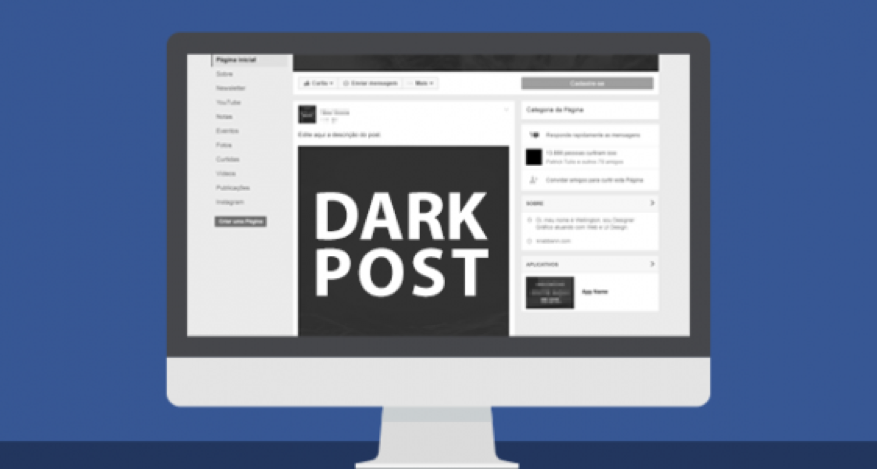Have you ever seen social media ads for companies you have never been in touch with it? More specifically, you might have seen Facebook ads. You may have tried to understand why you are getting these ads shown and what is the reason? Some users say they can’t find the ads shown on the official websites of those companies when they visit clicking the ads, and if you have clicked on the Facebook ads to reach the official website of the company but couldn’t see that ad there, you may be seeing a Facebook dark post. It uses those ads to target audiences and to generate leads.
Table of Contents
So, What Are Dark Posts?
You may have some confusion about dark posts and how they work. Mostly they are considered sponsored ads by various channels and are entirely different from dark social. For a clear understanding, here is what is a dark post.
Dark posts describe targeted ads that you can’t find on the advertiser’s timeline. They are not available on the feeds of the advertiser’s followers. Thus, it is dissimilar to boosted and organic posts. It will appear on your feed that they target. They label dark posts as sponsored content. For example, you may have seen some ads on your Facebook feed about the companies or organizations you never followed or liked a post. The reason is your trackable web behavior that reflects a portion of that company’s target audiences.
How Do Dark Posts Look?
It will look like the regular ads you see from different pages you might be following on your news feed. But when you click on that ad to land on the company’s website, it will not appear there. That’s it. It appears on your timeline because you don’t follow that particular company’s page. The reason for not appearing on the company’s website makes users call it a Dark Post.
The dark social describes the type of traffic earned on social media that social media tools can’t detect. Thus, it is not similar to dark posts.
What Are Facebook Dark Posts?
The Facebook dark posts are unique or different from others you have seen on the various social media channels. They have their separate names. They are Unpublished Pages or a type of Ads never published on the advertiser’s Business Pages. They show these ads on targeted customers’ news feeds. One can create a selection to distribute this type of ad through Ad Manager.
The Facebook dark posts allow better results for A/B Testing. You test these ads with the customers who already know your brand before you target new audiences. The Darks posts on Facebook let you control how many times and what type of audiences will see your posts. After creating dark posts, one can quickly manage how to show an ad when scheduling future dates. Thus, it is a part of the company’s promotion inside of the huge set.
You may call dark posts a little controversial because audience members interpret them as sneaky ads because of no personalized ad experience.
Facebook dark posts have been marked as Sponsored Posts, and they don’t have traditional designs. Audiences will see them on all Facebook-owned social media platforms.
What Is The Purpose Of Using Dark Posts?
It is necessary to know why you should use dark posts before you know how to create and use them on Facebook. Thus, in this section, I will make sure you understand the purpose of the dark posts.
- When willing to engage more audiences and show more specific ads on their news feeds, you can use dark posts. They provide more control over targeting audiences because it is still a type of ad. You can use it to introduce your brand, about, design, and lead generation. These bullets describe the purpose of dark posting posts.
- They let you complete A/B split testing, refining and optimizing your ads, and testing various elements. If you want to check some creatives, it allows you to use four ad creatives. They have similar copy and audiences. You can test a video vs. an image.
- When you target a young female audience to click on ad creatives featuring people of her age group, or sometimes, people want to split test various audiences to find out what works the best for their products, services, or campaigns.
- Every time you A/B test and optimize your targeted audience, they will receive more specific, and you cost less for your ad expenses. When you release a new service or product or when you are not sure about targeting audiences, it will help you. You can use it to give a special offer to a large part of your audience.
- While using dark posts on Facebook, you can target multiple groups of people. Darks posts are no spamming and give practical solutions for the advertisements.
How To Create And Use Dark Posts On Facebook?
Creating dark posts on Facebook is entirely different than you do with various types of ads. I have shared the details on how to create and use a Dark Post on Facebook. It includes several steps to complete the procedure. Go through these steps and create your unique dark posts.
- Navigate for Ads Manager or visit the Business Manager Menu to access your posts.
- Select the Page Posts section and start creating your first posts.
- Tap on to Create Posts and choose a type of your posts. You can upload photos, videos, carousels, stories, and links. The size of your dark posts will be the default and usual Facebook ads.
- To add CTA, choose the number of actions like Book Now, Subscribe, Get This Offer, Grab The Opportunity, etcetera.
- Choose ONLY USE THIS POST FOR AN AD, and it will not post it on your page to make it one of the Facebook dark posts.
- Again tap on Create Post. Congratulations! It is your dark post. It doesn’t go anywhere until you use it to crack your ad. Select your post using the tick button given on the left-hand side.
- Tap on the Actions button and choose to Create Ad.
- You can create Facebook dark posts for various objectives, but it gives few options. But you have to set up your ad campaign to have more options.
- Select targets, budget, and the time you want to run this ad, and if you use it to test, run the ad for a shorter period, not for weeks.
- Perform A/B Testing. You can choose live camping and tap on Duplicate to select this option, CREATE A TEST TO COMPARE A NEW AD SET TO YOUR ORIGINAL AD SET. Then after repeat this process. It allows you to test various elements like under;
- Ad Creatives
- New Audiences
- Varied Time Of Day Targeting
- Different Copy
- Facebook Ads Vs. Instagram Ads.
- It is essential to test only one element at one time to understand better what influences your results.
- Keep your budget the same and run two A/B tests at the same time. Otherwise, you can’t optimize it correctly. But you can also use more than two A/B tests simultaneously to test the number of ad creatives and audiences until you run the campaign elements the same.
Pro Tips To Use While:
Most advertisers have found that it is better to use one ad creative with one audience because it works better with the first than the second. Something that works for 35 years old may or may not work for 18 years old. Thus, it is essential to do ongoing tests and optimizations.
Optimization Of Your Facebook Dark Posts:
After successfully creating and publishing your post and set up A/B Testing, you have to optimize, measure, and report your ads. To optimize your recent posts, you have to review A/B tests based on your campaign objectives.
If you think about the perfect time to optimize, let me clear this. It depends on the length of your campaign and the money that you can afford to spend. In general, most advertisers see positive results in 24 hours. But if you have run a conversion campaign by selecting the Seven Days option, it means you can do it after the week.
If you have run the ad for the engagement, you will review the Cost Per Engagement. If you target traffic, you will Review Cost Per Click, and if you want conversions, you will Review the Cost Per Conversion. While looking for the best performing ads, you have to turn the ads off that have the highest cost per result. Thus, it is the optimization of your Facebook dark posts.
Final Thoughts:
Have you thoroughly understood that what is a dark post? In this article, I have summed up almost everything related to Facebook dark posts, why companies do create these posts, what are the purposes of running dark posts, create your Facebook dark posts, and how to optimize them for better results and cheaper cost of the campaigns you run for the engagement, conversion, or lead generation. This information must be enough for you to understand dark posting thoroughly.










